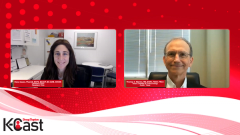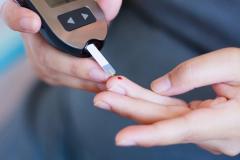
Challenges to Biosimilar Adoption of Insulin Glargine-yfgn
Thomas C. Blevins, MD, ECNU, FACE, FNLA, leads the discussion on potential challenges to the adoption of biosimilars in clinical practice, such as for insulin glargine-yfgn in diabetes management, and discusses the importance of patient and provider education.
Episodes in this series

Diana Isaacs, PharmD, BCPS, BCACP, BC-ADM, CDCES: I want to talk about some challenges institutions might face in trying to adopt biosimilars like Semglee [insulin glargine-yfgn]? What strategies can we use to try to overcome these challenges?
Thomas C. Blevins, MD, ECNU, FACE, FNLA: I was going to ask you that, but let me take a stab at it. How do we get people to use a biosimilar? You already said it. Some patients may say, “It’s a generic.” Well, it’s not a generic, but that’s what they’ll understand it as. It’s a biosimilar. They might think it’s inferior. That means educating ourselves and the practitioners to understand the data in a general way. People aren’t going to want to know all about those studies—INSTRIDE 1, INSTRIDE 2, and INSTRIDE 3. We need to talk to practitioners and educate them more about interchangeability and what it means. It needs to be repeated over and over. This is the first insulin that’s going to be interchangeable, and that should give everyone a lot of confidence. If the practitioners are able to educate themselves and educate the patient about—so utilization—the challenge will be educating people about the similar effect and highly similar molecule. It’s not some inferior thing. Then educate them about the potential for cost saving, which is important to all of us. It’s going to be a big education effort.
Diana Isaacs, PharmD, BCPS, BCACP, BC-ADM, CDCES: I totally agree. I just had an email the other day from 1 of our diabetes educators asking, “What’s this new thing, this interchangeable insulin?” There will need to be a big education effort, especially because people may have never heard of the name Semglee [insulin glargine-yfgn]. Or they see those insulin glargine with those additional letters—what does that mean? Why are there these extra letters there? It’s different. Education for the health care team and the patient—we’ve all got to be on board. The other thing, what’s important, is that prescribers always have a choice. When a prescription is put in, they can put “Do not substitute.” Of course, patients have a choice. Prescribers have a choice. That being said, we want to educate. But the outcomes are expected to be similar, other than the potential inactive ingredients, which can be slightly different. Other than that, everything is essentially identical. We want to just make sure everyone is on the same page with that and everyone really knows that so they’re ready.
Thomas C. Blevins, MD, ECNU, FACE, FNLA: I completely agree.
Diana Isaacs, PharmD, BCPS, BCACP, BC-ADM, CDCES: I’m curious. Do you have any ideas, any strategies for how we get this education? Hopefully educational programs. Any strategies or something you do in your in your office to help educate all those staff so they’re prepared with this new information?
Thomas C. Blevins, MD, ECNU, FACE, FNLA:We’re still using a lot of this video approach. That’s what we’re doing with the staff. We have education meetings—getting everyone on and defining these terms are important. Interchangeability—what does it mean and how do you get it? Biosimilar vs generic. There’s a lot of blurring of terms. Understanding the quality of the agent is important. Then we need to talk to our staff and, as you were talking about, educate patients about this. If you go to the pharmacy, you might get another medication. It’s not like you’ve been taken advantage of. You’re getting a really good medication. It’s right on target, so why would I write “Do not substitute”? I don’t think I would. We’re going to get feedback from patients and doctors about those things, and some people will have strong opinions.
We just have to educate—you’re right, we have to. It’s a big effort, and maybe some information bulletins, maybe people talking on some of the education channels like we’re doing. Everyone in the country should hear this show. That’s what I think. There’s a lot of work. A lot of information dissemination. The pharmacist will be a very big part of this, perhaps the biggest part. Having the pharmacist understand this is important, and we can be proactive in terms of education. The last thing is that the guidelines need to say something about this to us. The guidelines speak to us, and all the diabetes treatment guidelines—the ADA [American Diabetes Association], the American Association of Clinical Endocrinology, the European group, the Indian Medical Association, Asian, and everybody around the world—need to say something about this.
Diana Isaacs, PharmD, BCPS, BCACP, BC-ADM, CDCES: I agree. The guidelines need to mention this so people know that this is an option that can help with cost saving. With insulin, which is really a lifesaving, life-needing medication, there’s a lot of interest in what we can do to reduce the cost. This is a mechanism to do that, and it’s a really important 1. We’ve got to get the word out. I agree with you that pharmacists have an important role with this. Because pharmacists now can directly interchange this insulin, it’s going to be important that they educate patients. That may be the first time the patients hear about it. They may go to the pharmacy, and they’re ready to fill their usual Lantus [insulin glargine] prescriptions and then they open their bag and have Semglee [insulin glargine-yfgn]. It’s essential that the pharmacist spend some time explaining the difference. I don’t think it takes much time. You’re just explaining that this is expected to work exactly the same. The doses are going to be the same. If you’re taking 10 units of Lantus [insulin glargine], you’re going to take 10 units of Semglee [insulin glargine-yfgn]. Understanding that is so important. Perhaps it’s putting leaflets into the bag explaining, but we need to let patients know. Otherwise, there are going to be a lot of phone calls to the pharmacies or doctor’s offices saying, “What happened? Did I get the wrong drug? Was this is a mix up?” We owe it to our patients to be transparent with everything and explain that this is truly what’s best for everyone. This is in everyone’s best interests.
Transcript Edited for Clarity
Newsletter
Pharmacy practice is always changing. Stay ahead of the curve with the Drug Topics newsletter and get the latest drug information, industry trends, and patient care tips.













































































































































































































